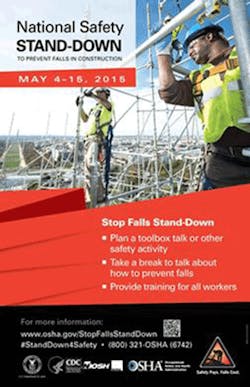Not For Scaffold Use: Three Massachusetts Roofers Hospitalized When Scaffolding Breaks
Three roofing workers employed by Provencher Home Improvement of Beverly, Mass. were hospitalized after a two-story fall from a scaffold platform that broke beneath them, according to OSHA. The incident occurred, inspectors said, because a spruce plank used as the platform could not support the workers’ weight, was not graded for scaffold use and the plank’s invoice was clearly marked “not for scaffold use.”
OSHA found numerous violations in its inspection and has cited the company’s owner, Daryl J. Provencher, with fines totaling $294,500. The incident underscores the severity of fall hazards in the construction industry. Each year, hundreds die as a result of falls, many of which are preventable when proper safety rules are observed.
“Had this employer obeyed the law and followed OSHA standards, this incident and the resulting serious injuries to three workers would not have occurred. It was completely preventable,” said Dr. David Michaels, assistant secretary of labor for occupational safety and health. “Instead of purchasing and using scaffold-grade planking that could support the load, this employer needlessly gambled with the safety and well-being of its employees.”
The incident occurred as the employees performed roofing work on a ladder-jack scaffold at 12 Parsons Hill Road in Wenham on Oct. 2, 2014, at an A.C. Castle Co. Inc. job site. In addition to a number of significant safety violations, the investigation found that the operations of Danvers-based A.C. Castle Construction Co. Inc. were sufficiently integrated with Provencher’s to render the two a single employer of the affected workers.
The three workers who fell were taken to local hospitals for treatment. Two were admitted as inpatients and the third received outpatient treatment. Their injuries included spinal, eye, facial, chest and rib fractures, broken bones, broken ribs and a punctured lung.
“While the affected workers here were nominally employed by Provencher, A.C. Castle exercised a degree of control and oversight over Provencher’s operations sufficient to render the two a single employer under the OSH Act, responsible as one entity for their employees’ safety,” said M. Patricia Smith, solicitor of labor. “We will hold business entities responsible as employers where the circumstances so warrant, even in the face of claims by some to the contrary.”
OSHA identified additional alleged hazards at the Wenham job site, including scaffold platforms that exceeded the maximum allowable height of 20 feet, ladders that did not extend at least three feet above landings for stability and not ensuring that the employees were using fall protection. Other hazards encompassed the use of defective or damaged scaffold components, having missing or inadequate scaffold anchorage and failure to train employees in scaffold erection and safety. These conditions resulted in the company being cited for three willful, one repeat and five serious violations.
The willful and repeat violations stem from Castle/Provencher’s knowledge of the hazards and prior history of OSHA violations.
A.C. Castle had been inspected three times by OSHA since 2005, and Daryl J. Provencher, doing business as Provencher Home Improvement, had been inspected twice since 2011, resulting in a total of 47 violations and $123,720 in fines for the two entities. Three of the inspections involved scaffold violations, five involved ladder hazards and three involved fall protection violations. The previous inspections took place at Massachusetts work sites in Danvers, Hamilton, Peabody, Revere Beach and Salem.
Falls Are a Leading Cause of Death
Falls are the leading cause of death in construction work. In 2013, there were 294 fall fatalities out of 796 total fatalities in construction. To raise public awareness and reduce fall-related hazards and injuries, OSHA has an ongoing Fall Prevention Campaign.
Additionally, the second national Fall Safety Stand-Down will be held May 4-15. Employers and workers will pause during their workday for safety topic talks, demonstrations and training on how to use safety harnesses, guard rails and other means to protect workers from falls.
“There are employers who provide fall protection and take pride in it. Many of them will participate in the Stand-Down and we encourage other employers to do so as well,” said Michaels. “It’s a small investment of time, resources and knowledge that will pay big dividends for both workers and employers.”
A.C. Castle/Daryl J. Provencher has 15 business days from receipt of its citations and proposed penalties to comply, meet with OSHA’s area director, or contest the findings before the independent Occupational Safety and Health Review Commission.



